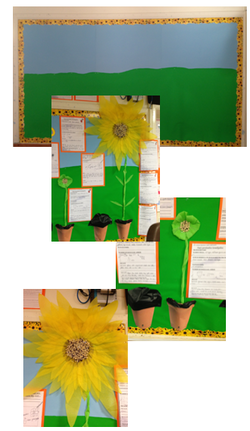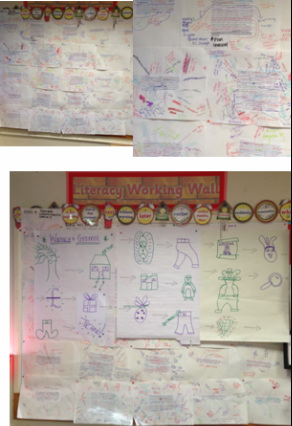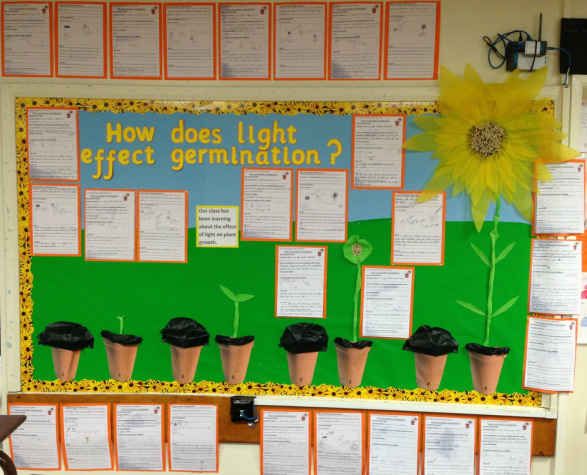GPP - 4th - 15th November 2013
First day of GPP
A bus and 2 trains later I made it to my school in Ashton-under-Lyne to meet my year 6 class for the first time. They are a spirited class and a range of abilities which will be a good challenge for my teaching and learning skills, especially with regard to thinking about differentiation and inclusion. The next 8 weeks prove to be a time filled with fun, stress, new experiences and a steep learning curve! Roll on GPP!
A bus and 2 trains later I made it to my school in Ashton-under-Lyne to meet my year 6 class for the first time. They are a spirited class and a range of abilities which will be a good challenge for my teaching and learning skills, especially with regard to thinking about differentiation and inclusion. The next 8 weeks prove to be a time filled with fun, stress, new experiences and a steep learning curve! Roll on GPP!

This is the cross-curricular science and English display I designed and made whilst on GPP.
How does light affect germination?
The children conducted an experiment to investigate how light affects germination and wrote up the experiment as a report, including their findings.
The display was designed to reflect the process of the experiment, displaying each stage of germination over the four weeks that the experiment ran. Key words associated with the topic, such as ‘germination’, ‘seed’, ‘light’, ‘independent variable’, ‘dependent variable’ and ‘fair test’ were displayed, as well as key questions we asked when predicting the outcome of the experiment. The children’s written up reports were also displayed to show the findings and celebrate the children’s work.
How does light affect germination?
The children conducted an experiment to investigate how light affects germination and wrote up the experiment as a report, including their findings.
The display was designed to reflect the process of the experiment, displaying each stage of germination over the four weeks that the experiment ran. Key words associated with the topic, such as ‘germination’, ‘seed’, ‘light’, ‘independent variable’, ‘dependent variable’ and ‘fair test’ were displayed, as well as key questions we asked when predicting the outcome of the experiment. The children’s written up reports were also displayed to show the findings and celebrate the children’s work.
Cross-curricular display on GPP – Analysis
The purpose of the display was to create an eye-catching, colourful display to convey ideas and concepts in an attractive and effective way and in order to create a stimulating learning environment, as the environment has a large effect on children’s learning and motivation. As well as this, to celebrate the children’s work and show them that their work is valued, as this creates a sense of achievement and enhances motivation.
The whole class had their work displayed in order to celebrate all their effort and to allow children to celebrate their own work and the work of their classmates. The display not only showed their own work, but acted as a learning resource as the use of key words associated with experiments in science, this also reinforced key vocabulary and enriched learning.
The display used a variety of difference materials and parts of it were made in 3D in order to make it more engaging and interactive for the children. When the display was completed all the children were interested in looking at it and at commented that it they liked the 3D plant pots and sunflowers.
The purpose of the display was to create an eye-catching, colourful display to convey ideas and concepts in an attractive and effective way and in order to create a stimulating learning environment, as the environment has a large effect on children’s learning and motivation. As well as this, to celebrate the children’s work and show them that their work is valued, as this creates a sense of achievement and enhances motivation.
The whole class had their work displayed in order to celebrate all their effort and to allow children to celebrate their own work and the work of their classmates. The display not only showed their own work, but acted as a learning resource as the use of key words associated with experiments in science, this also reinforced key vocabulary and enriched learning.
The display used a variety of difference materials and parts of it were made in 3D in order to make it more engaging and interactive for the children. When the display was completed all the children were interested in looking at it and at commented that it they liked the 3D plant pots and sunflowers.
21st November 2013

These are some of the images from the working wall I created for literacy.
In my year 6 class we were writing an adventure story based on Wallace and Gromit The Wrong Trousers using Pie Corbett's Talk for Writing.
The images show the work completed by the children in groups to analyse the structure, techniques and language used by the author to make the story exciting and engaging.
I found creating a working wall beneficial for the children as they were able to engage with the learning and had a visual reminder of the key vocabulary, structure and techniques to incorporate into their writing.
In my year 6 class we were writing an adventure story based on Wallace and Gromit The Wrong Trousers using Pie Corbett's Talk for Writing.
The images show the work completed by the children in groups to analyse the structure, techniques and language used by the author to make the story exciting and engaging.
I found creating a working wall beneficial for the children as they were able to engage with the learning and had a visual reminder of the key vocabulary, structure and techniques to incorporate into their writing.


